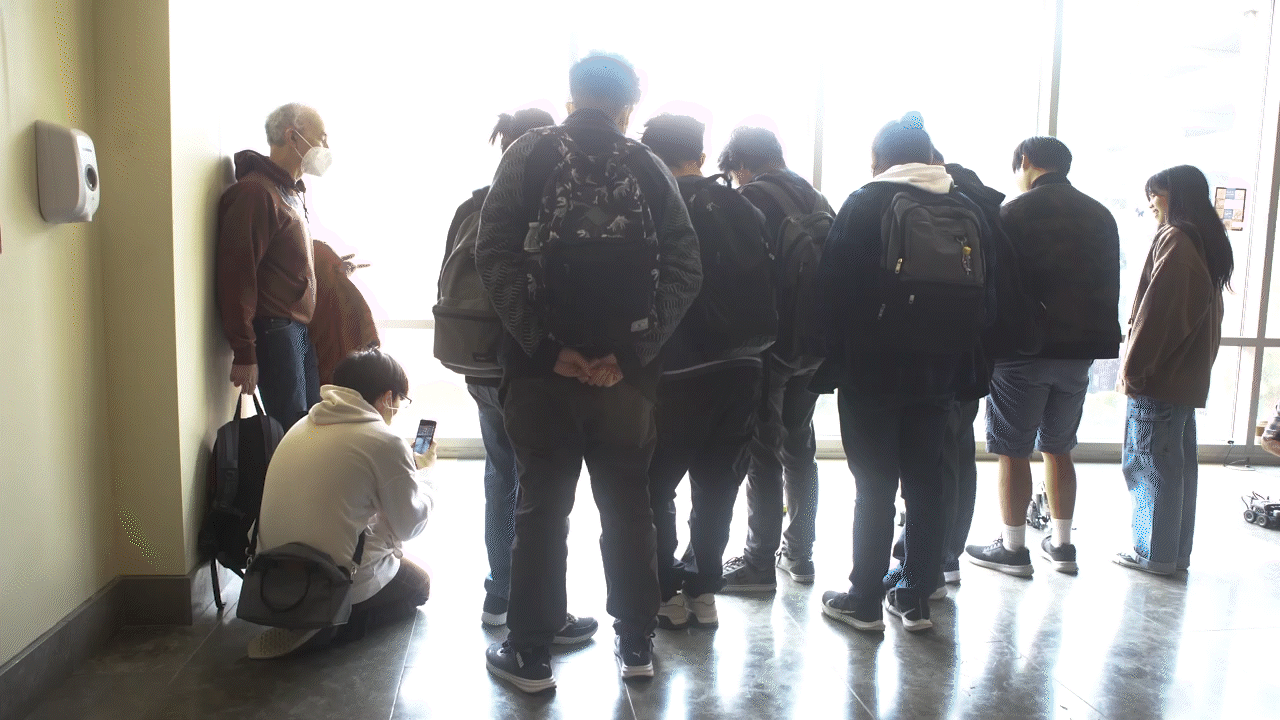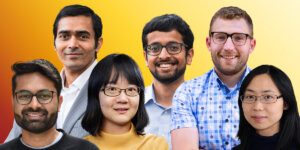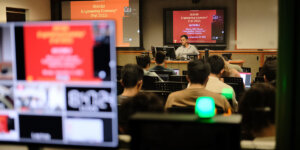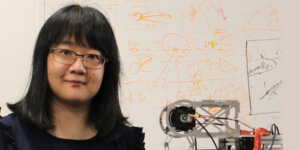
Eric Deng, an electrical engineering student, watches as kids interact with Now the robot at the USC Robotics Open House April 1, 2018. Photo by David Sprague
A playground with robots, the USC Robotics Open House is an annual event that fires up the creativity and imagination of young K-12 students through cool demos and fun activities that prove science is an interactive, enjoyable, and fulfilling discipline of study and research.
“Even though we do this every year, there is an insatiable demand for it,” said Katie Mills who organized and managed the event as outreach manager for USC Viterbi’s Adopt-a-School Adopt-a-Teacher (VAST) K-12 STEM program.
More than 1,700 students, educators and parents, some traveling from as far away as Las Vegas, got a front row seat to the technology coming out of the USC Viterbi Robotics and Autonomous Systems Center (RASC) – home to one of the most diverse collections of robots in the nation. With over 80 active research robots, RASC projects span the areas of service, humanoid, distributed, reconfigurable, space, and nano robotics. Students also interacted with the people responsible for building and working with these robots.
“The whole purpose of the Robotics Open House is to engage students and teachers in the engineering research process,” Mills said. “We want them to be in the labs and to understand that it is young people like them, of all genders and ethnicities, doing this research.”
A post-event survey gauged the impression left on the young students. Eighty-three percent said that their visit made them want to study engineering. Eighty percent of girls in attendance, the majority of whom come from Hispanic backgrounds and are potential first-generation college students, said that the event changed their understanding of engineering and piqued their interest in studying engineering subjects.
Robotics seems to have renewed interest in STEM courses like none other, Mills explained, because it brings science, technology, engineering and mathematics which are often taught as four different subjects, together as one. Given that STEM occupations are growing at approximately twice the rate of non-STEM courses according to the Office of Science and Technology Policy, renewed interest in these subjects is good news for a nation hoping to fill an inadequate pipeline of teachers and students who are proficient in these vital areas.

Drones at the USC Robotics Open House April 1, 2018. Photo by David Sprague
Assistant Professor of Aerospace and Mechanical Engineering Mitul Luhar, who studies turbulence and fluid mechanics, demonstrated the use of robots in the water channel of his lab. Luhar uses robots to measure what turbulence does to environments like coastal regions and even deeply buried underground pipes that crisscross our cities.
Next door was Assistant Professor of Computer Science Nora Ayanian’s drone lab. Ayanian, who is the Andrew and Erna Viterbi Early Career Chair, creates end-to-end solutions for multirobot coordination to enable almost anyone to use teams of robots: from drones used in aerial photography to robot teams used to rescue people from burning buildings.
Dr. Monish Aron of the Keck School of Medicine was also on hand to discuss his work doing robotics surgery on humans. His videos showing robots performing laparoscopic surgery on bladders and kidneys were a hit with students from medical pathway high schools.
A panel of electrical engineering professors led by Hossein Hashemi, Ming Hsieh Faculty Fellow in Electrical Engineering-Electrophysics and Bhaskar Krishnamachari, Ming Hsieh Faculty Fellow in Electrical Engineering-Systems, of the Center of Cyber-Physical Systems and the Internet of Things, discussed autonomous vehicles.
Meanwhile, student organizations like Theta Tau provided more demonstrations like robots that paint. In all, 100 student and faculty volunteers participated in this year’s Robotics Open House.
“We had tremendous help from USC students, especially members of student organizations like Spark SC, NSBE and Theta Tau,” Mills said. “We couldn’t have done it without their help.”
Making their way through the maze of robotics labs students met the usual suspects like Bandit, a humanoid robot built to interact with humans. Bandit began its legendary journey in the lab of Maja Matarić, a pioneer in the field of socially-assistive robotics and the Chan Soon-Shiong Chaired Professor of Computer Science. Then, there was the EcoMapper, an autonomous underwater vehicle (AUV) that maps water quality, water currents and bathymetry, out of Gaurav Sukhatme’s Robotics Embedded Systems Lab. Sukhatme is the Executive Vice Dean of Engineering and the Fletcher Jones Foundation Endowed Chair in Computer Science.
Students were then invited to participate in a panel that featured entertainers and innovators in tech like Jon Burton, one of the producers of The LEGO Movie and designer of hit LEGO video games like LEGO Star Wars and later LEGO Batman.
Where Burton showed the students where their careers could take them, panelist Kathy Kemper, CEO and director of the Institute for Education, offered a starting point.
“Three years ago, I decided to help USC Viterbi start a computer science coding camp,” said Kemper who together with Mills aims to expand the camp’s targeted demographic to boys and girls from all backgrounds, either economically or ethnically, to give them a greater understanding of computer science.
The SC Coding Camp, CS@SC, will be held again this July. In addition to the many camps offered throughout the summer, like the SHINE program, there are also student-led initiatives like Hack Sc Jr. a hackathon especially designed for elementary and middle school students from the LA area.
Published on April 26th, 2018
Last updated on August 7th, 2020












